Back in mid-November, I wrote a piece called "A Dirty Word".
In that post, I discussed stagflation (the eleven-letter word) and said that it
was starting to sneak out of economists' mouths in dark corners and rarely
visited discussion groups. Today, it is being widely discussed and many openly
fear our slipping into the dark, dark world of stagflation. Is stagflation
becoming a reality, or is it just a scary talking point? Here is a link
to November's piece if you want to review.
To save you a little time and consternation, let me first review with you the definition of stagflation.
Stagflation is defined by three concurrent economic conditions—none of them good:
- Rising prices - a.k.a. inflation
- High unemployment
- A period of extended, slow economic growth
Let's start with inflation,
because unfortunately it is the easiest to identify and is most frequently in
the headlines today. Statista provides this stark graph.
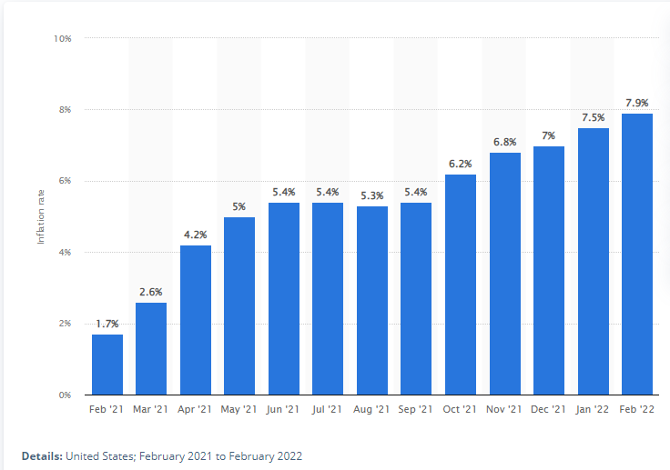
Back when I wrote the November post, it was shocking to see the gas prices in California crossing the $5 per gallon barrier. Look at the difference just five short months can make to our perception of "normal".
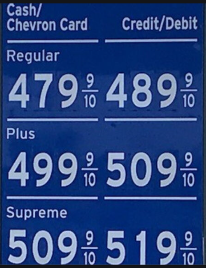
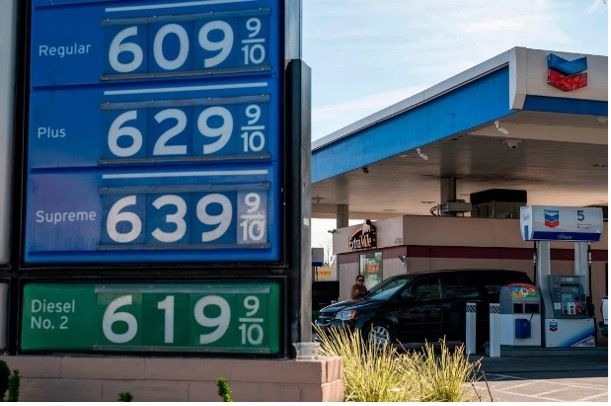
Personally, the cost to fill my cars' tank has gone to and
sometimes beyond, $100. I think the local gas stations here in Illinois have
raised the max take for a pump from $75 to well over $100. For smaller cars in
the United States, the gas tank capacity can be around 12 gallons. For larger
cars, it is usually 15-16 gallons, and for many trucks, it can be around 20
gallons. Whether or not you want to blame this on the war in Ukraine or
political wrangling here in the U.S. it doesn't really matter. Gas, diesel
fuel, natural gas, and heating oil prices all have soared. The recent release
by President Biden of one million barrels of oil per day from the strategic
reserve is little more than a short-term band-aid.
Now, let's very briefly discuss food costs. I quickly tabulated the raw cost of grains from last year to this year (source: Bloomberg - front-month futures). As has been widely reported in the news, Ukraine and Russia are both massive suppliers of grains, particularly wheat, and it should not surprise us that those prices are up. Of course, livestock need feed, and farmers need to power their equipment. Here is a brief sample of some of the prices of common agricultural products.

So, I think we won't have a huge argument about the
inflation part of this nasty little mix of conditions we call stagflation, but
what about the employment and output components?
High Unemployment
This is a real head-scratcher, because we have been through such a whirlwind in the past two years. According to the official data from the Federal Reserve Bank of New York, the unemployment rate in the United States has come down quite dramatically from the very scary highs at the start of the pandemic.
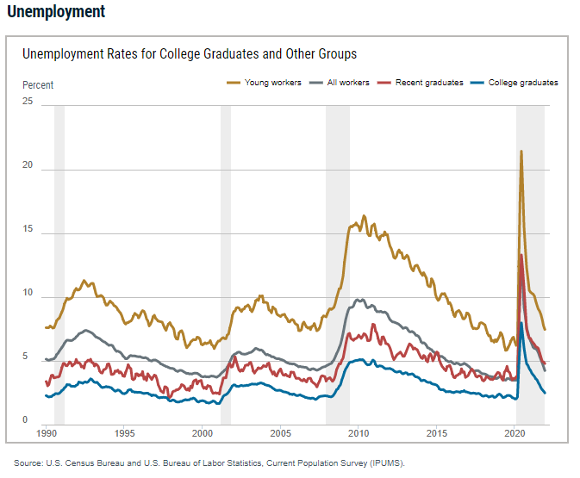
However, another stat from the same source would tell us
that on average, 42.5% of college graduates are currently described as
underemployed. The Federal Reserve Bank of New York defines underemployment as
"working in a job that typically does not require a bachelor's
degree". Recent college graduates are those aged 22 to 27 with a
bachelor's degree or higher. What does it really mean that so many college
graduates are underemployed? I think that is an important and lengthy
discussion. According to my research, this number is both a little fuzzier and
much less reported than the unemployment rate. It appears to me that historically,
around 20-25% of Americans are usually underemployed. It seems that we are
currently well above that number today.
So, the stats would tell us that the second part of
stagflation does not appear to be in place. In fact, it seems somewhat far off.
However, I think we can all see that the labor market is disturbed and rapidly
changing. I'm not quite sure what the massive shift from working in offices to
working in the home will eventually alter, but I do believe it will have
significant impacts going forward. Will it be a net positive or a net negative—I
think it's too early to tell. The next 12-36 months should tell a very
interesting story about the commercial real estate market. Everything from
shopping malls to office buildings, to downtown corridors will be affected. I
make sure to peek at the parking lot of the train station I commuted from for
20 years…it's still significantly below 50% full. If you start to think about
it, there is a new generation of employees that have never even been
asked to regularly work from an office. This must have an impact on the future
of business in lots of yet unidentified ways.
Extended, Slow Economic Growth
I'm going to start this section by referring to my favorite
economic formula: M x V = P x Q. As the Fed starts to play defense against the
rampant inflation discussed above, one of their key tools will be to slow the
growth of the money supply (M). We are already seeing this to some degree, but
you can bet that if inflation continues apace, the growth of the money supply
will slow. Velocity (V) remains historically low. We have already discussed
prices (P) via the examination of inflation, which leaves us with output,
a.k.a. GDP (Q). If the formula is correct, we currently have M still trending
slowly higher and V remaining very low. If the other side of the equation is
going to remain in balance, with P roaring higher, then Q cannot grow.
This is why the Fed must try to stop—or at least
dramatically slow—inflation. It must, and it will likely try to do so by raising
short-term rates. We have seen this process begin and we will likely see more
of it. I discussed this in my last post at some length.
However, when we look at the current GDP (see graphic below from Statista), economic growth appears to be holding steady. I take the stats at face value, but I think we also must take the amazing shifts we saw during the pandemic into account. What will the medium-term effects be? Again, we don't know the future, but I believe it will be significant. Time will tell.
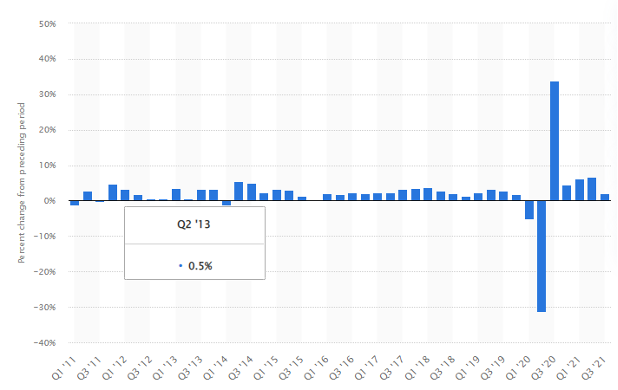
So, some good news: I think we can say that we have not
entered a period of stagflation…yet!
It is a rare and terrible cycle point that we need to avoid
at all costs. I do think that since I first covered the topic we have been staring
into that abyss for a while. Somewhere along the way, we could have easily
slipped into a terrible downward spiral, but so far, haven't. The war in
Ukraine obviously did not help. On a positive note, the airports have been
packed and the airline stats are looking pretty good over the spring break
period. People really want to return "to normal". If we do return to more
normal activity levels, perhaps we can leave this long and dirty word—stagflation—in
our rearview mirror!
Final, final thought: We are having a hard time breaking out
of winter here in Chicagoland, but grilling season is moving ever nearer.
Please send me some of your favorite recipes that can be enjoyed in the
sunshine.
Fill out the form below to subscribe to my weekly blog.


